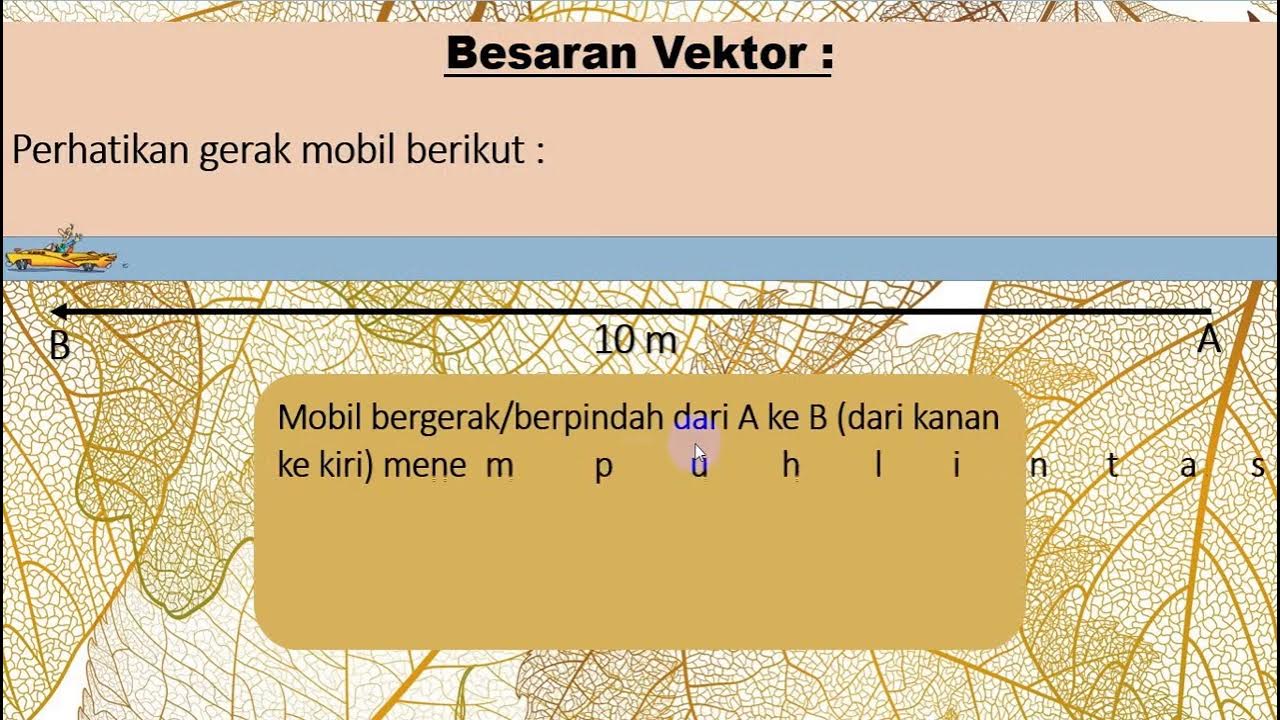GCSE Physics Revision "Scalar and Vector Quantities"
Summary
TLDRIn this educational video, the distinction between scalar and vector quantities in physics is clearly explained. Scalar quantities, such as mass and temperature, possess only magnitude, whereas vector quantities, including displacement and velocity, have both magnitude and direction. The video uses a map to illustrate the concept of distance as a scalar, contrasting it with displacement as a vector, represented by an arrow indicating direction. Viewers are encouraged to practice these concepts with questions in the provided workbook.
Takeaways
- 📚 The video is part of a series on 'three sighs', focusing on teaching the concepts of scalar and vector quantities in physics.
- 🔍 Scalar quantities are defined as having only magnitude, with no direction. Examples given include mass, temperature, speed, energy, distance, and time.
- 📏 Distance is used as a specific example of a scalar quantity, illustrating that it provides no information about direction.
- 🗺️ A map is used to visually represent the concept of scalar quantities, showing that multiple locations can be the same distance from a starting point without indicating direction.
- 🚀 Vector quantities are described as having both magnitude and direction, with examples such as displacement, weight, force, velocity, acceleration, and momentum.
- 🧭 Displacement is highlighted as a vector quantity, differentiating it from distance by emphasizing its directionality.
- 🔄 The concept of displacement is further explained with an example of a journey, where the traveled distance and the displacement due to direction are not the same.
- 🏹 Vectors are represented using arrows, where the length of the arrow indicates magnitude, and the direction of the arrow indicates direction.
- 📚 The video script mentions a workbook with questions on scalar and vector quantities, which can be accessed through a provided link.
- 🎓 The video aims to ensure that viewers can describe what scalar and vector quantities are and how to represent vector quantities by the end of the video.
- 🎬 The script is structured with an introduction, explanation of concepts, examples, and a conclusion, including a call to action for further learning materials.
Q & A
What are scalar and vector quantities?
-Scalar quantities have only magnitude, such as mass, temperature, speed, energy, distance, and time. Vector quantities have both magnitude and direction, such as displacement, weight, force, velocity, acceleration, and momentum.
Why are scalar quantities said to have no direction?
-Scalar quantities do not have a direction because they only describe the size or magnitude of a physical quantity, without indicating the direction of that quantity.
Can you give an example of a scalar quantity?
-An example of a scalar quantity is distance, which tells us how much ground has been covered but does not indicate the direction of travel.
How is a vector quantity different from a scalar quantity?
-A vector quantity is different from a scalar quantity because it includes both magnitude and direction, whereas a scalar quantity only has magnitude.
What is the significance of magnitude in vector quantities?
-The magnitude in vector quantities is significant as it represents the size or strength of the quantity, such as the length of the arrow in a vector representation.
How can the direction of a vector quantity be represented?
-The direction of a vector quantity can be represented by the direction of an arrow in its graphical representation, indicating the specific way in which the quantity is applied or moves.
What is displacement and why is it considered a vector quantity?
-Displacement is the change in position of an object and is considered a vector quantity because it has both magnitude (the distance moved) and direction (the specific way the object has moved).
How can the concept of displacement be illustrated using a map?
-Displacement can be illustrated on a map by using an arrow to represent the vector. The length of the arrow shows the magnitude (how far the object has moved), and the direction of the arrow shows the direction of movement.
What is the difference between distance and displacement in terms of direction?
-Distance is a scalar quantity that measures the total path length traveled without regard to direction. Displacement, on the other hand, is a vector quantity that includes both the magnitude of the movement and the direction in which the movement occurred.
How can the concept of vectors be applied in physics?
-Vectors are applied in physics to describe quantities that have both magnitude and direction, such as force, velocity, and acceleration. They are essential for solving problems involving motion, forces, and other phenomena where direction matters.
Where can I find more practice questions on scalar and vector quantities?
-You can find more practice questions on scalar and vector quantities in the 'vision workbook' which can be accessed by clicking on the provided link in the video description.
Outlines

このセクションは有料ユーザー限定です。 アクセスするには、アップグレードをお願いします。
今すぐアップグレードMindmap

このセクションは有料ユーザー限定です。 アクセスするには、アップグレードをお願いします。
今すぐアップグレードKeywords

このセクションは有料ユーザー限定です。 アクセスするには、アップグレードをお願いします。
今すぐアップグレードHighlights

このセクションは有料ユーザー限定です。 アクセスするには、アップグレードをお願いします。
今すぐアップグレードTranscripts

このセクションは有料ユーザー限定です。 アクセスするには、アップグレードをお願いします。
今すぐアップグレード関連動画をさらに表示

Introdução ao Estudo da Física e Grandezas | Física - aula #1 | prof. Yuri Alves | Extensivo NPAC

Besaran vektor dan besaran skalar (Fisika SMA/MA Sagufindo kls X smt 1 : Vektor)

A Teoria do Movimento | Episódio 2

Cinemática 04: Grandezas Vetoriais e Escalares

BESARAN BERDASARKAN ARAHNYA | Vektor #1 - Fisika Kelas 10

Scaler vs Vector || Difference between Scale and Vector Quantity
5.0 / 5 (0 votes)
